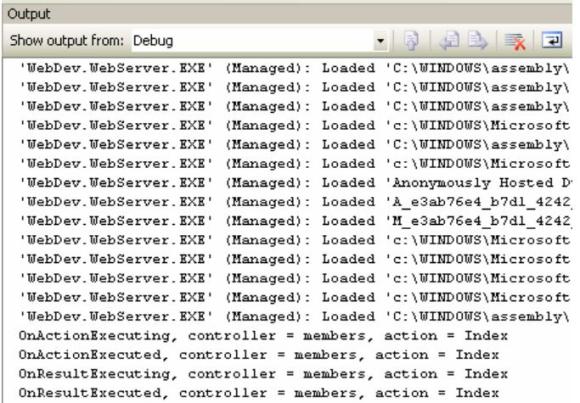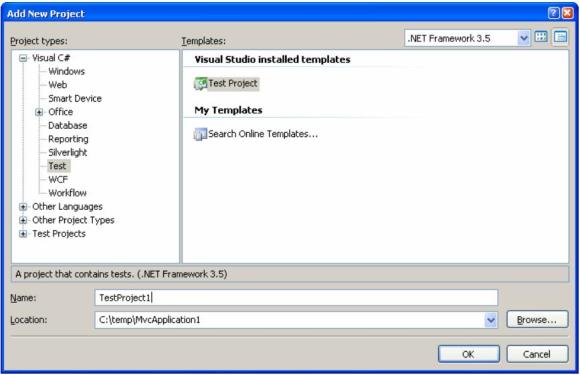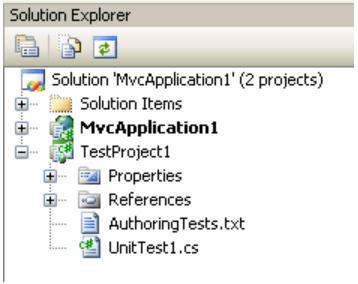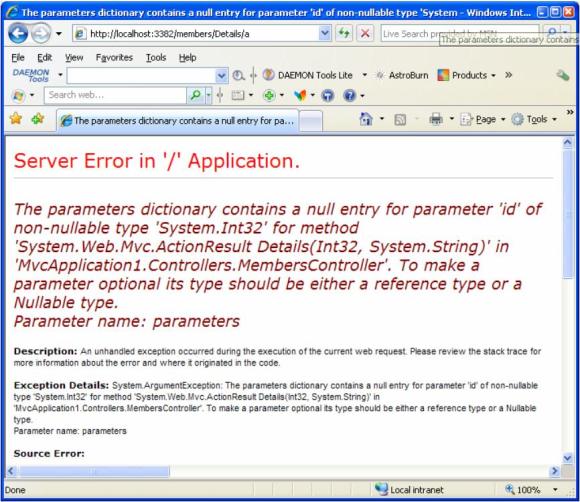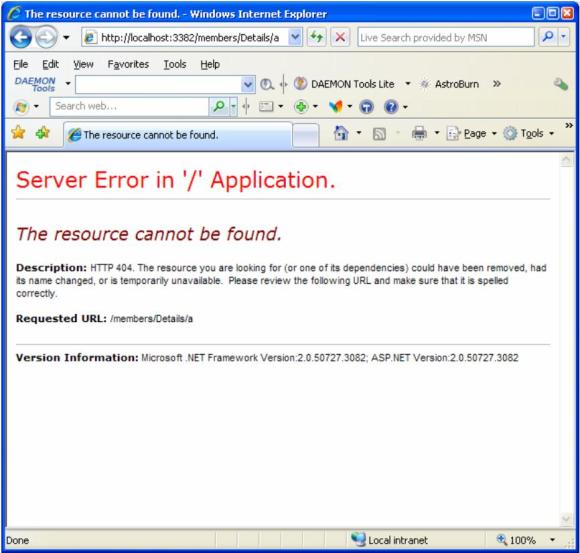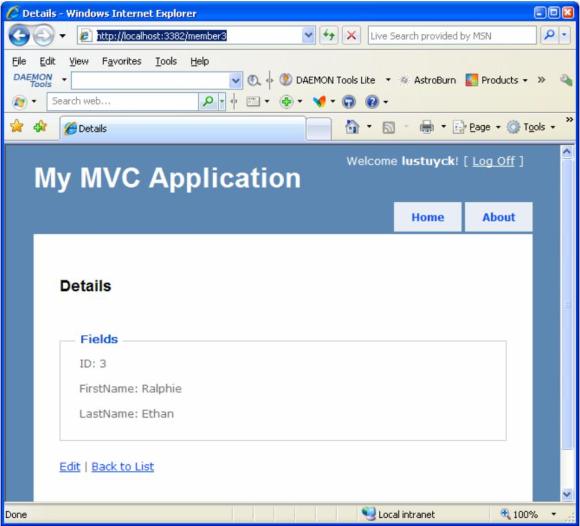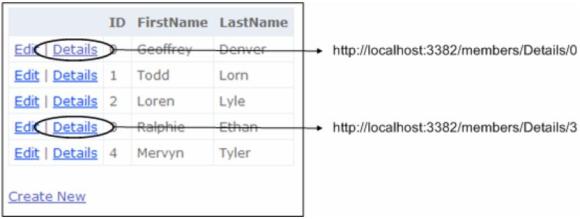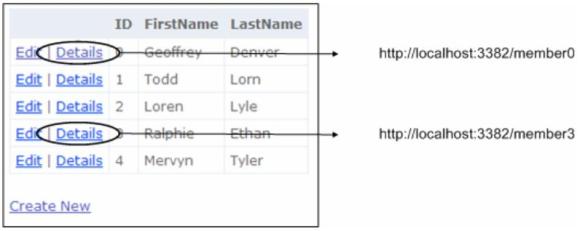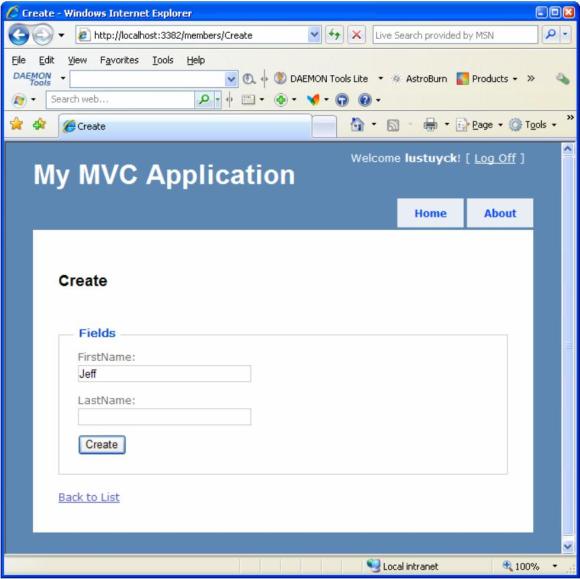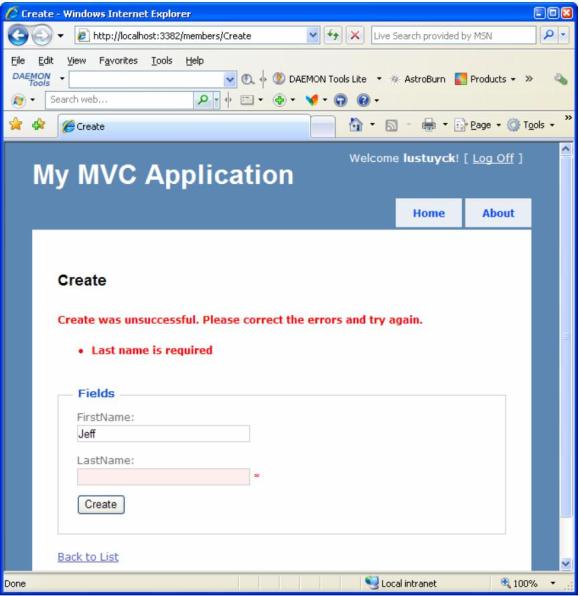…continued from part 2.
Objectives
In this Hands-On Lab, you will create functionality to display the details of a member and add admin functionality to add, edit and delete members. In particular, you will:
- Task 1: making the Details link work
- Task 2: making the Create New link work
- Task 3: making the Edit link work
- Task 4: making the Delete link work
- Task 5: adding validation
System requirements
You must have the following items to complete this lab:
- Microsoft Visual Studio 2008 SP1 (professional edition)
- Microsoft ASP.NET MVC 1.0
Prequisites
You must have the following skills to understand this lab:
- Fundamental knowledge of software development in .NET 3.5
- Some experience in ASP.NET web development
This lab builds further on the QuickStart 2 code.
Task 1: making the Details link work
When you click on the Details link, you would expect to see a page with the details of that specific member.
First, start the web application again and hover the Details links to see the URL each link refers to (generated by the Html.ActionLink methods):
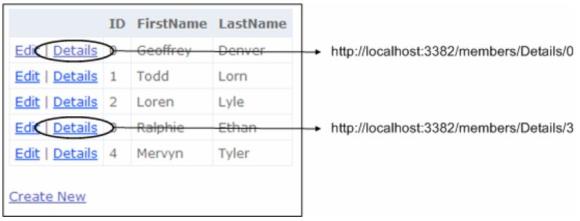
It’s interesting to see that these URL’s don’t use some exotic querystring to indicate the ID of the member; instead it’s a clean URL that is routed to the Details action method of the MembersController. So we’ll proceed by writing that action method to handle clicks on the Details links.
The first thing we need to do is to update our Model code so that we can retrieve the details of a member, because that’s the responsibility of the model. So open the MemberService class in the Model folder, and add the following method:
public static Member GetMember(int id)
{
return members.Find(m => m.ID == id);
}
This simply uses a lambda expression to find the member with specified id in the members collection.
Now we will create the controller action: open the MembersController class in the Controllers folder and add the following method:
public ActionResult Details(int id)
{
// Get member details for the specified member id
Member member = MemberService.GetMember(id);
// return this member to the default view
return View(member);
}
Finally we have to create the view that will show the member details. Right click the Details method and select Add View, and make sure everything is filled in as follows:
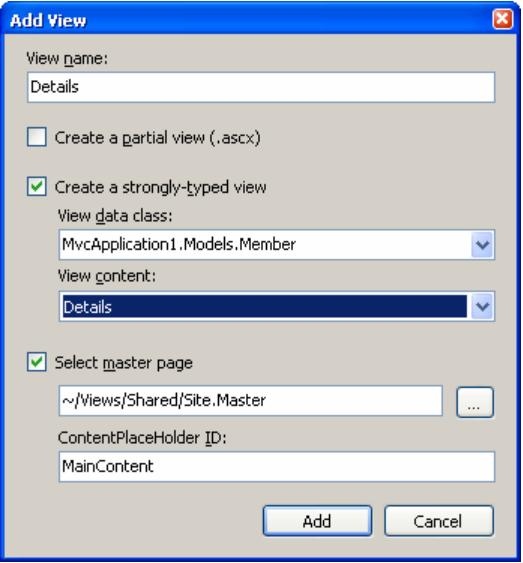
Make sure that:
- The View name is called Details.
- You check the Create a strongly typed view check box, and set the View data class to MvcApplication1.Models.Member. This way, we will be able to access the member data in the view in a strongly typed way.
- Select Details as the View content. This will generate code that displays the details of a member.
Click Add. As a result, a Details.aspx view is added to the Views/Members folder:
<%@ Page Title="" Language="C#"
MasterPageFile="~/Views/Shared/Site.Master"
Inherits="System.Web.Mvc.ViewPage<
MvcApplication1.Models.Member>" %>
<asp:Content ID="Content1" ContentPlaceHolderID="TitleContent"
runat="server">
Details
</asp:Content>
<asp:Content ID="Content2" ContentPlaceHolderID="MainContent"
runat="server">
<h2>Details</h2>
<fieldset>
<legend>Fields</legend>
<p>
ID:
<%= Html.Encode(Model.ID) %>
</p>
<p>
FirstName:
<%= Html.Encode(Model.FirstName) %>
</p>
<p>
LastName:
<%= Html.Encode(Model.LastName) %>
</p>
</fieldset>
<p>
<% =Html.ActionLink("Edit", "Edit", new
{ /* id=Model.PrimaryKey */ }) %> |
<%=Html.ActionLink("Back to List", "Index") %>
</p>
</asp:Content>
And again, replace the documented code in the action links so that we assign the primary key to each member instance for the Edit link:
<%= Html.ActionLink("Edit", "Edit", new { id=Model.ID }) %> |
Put a breakpoint at the first line in the Details action method in the MembersController and hit F5 to debug the application. Change the url to http://localhost:3382/members/index and click on the Details link of a specific member. When the breakpoint hits, you can see that the id parameter of the action method equals the id of that specific member:

Now how does the action method knows this id? This is because of model binding feature of ASP.NET MVC. Your action methods need data, and the incoming HTTP request carries the data it needs, which can be in the form of query string, posted form values and so on. So if you click such link, a new request is created containing the id; and the DefaultModelBinder automatically takes that member id out of the request and maps it to the id parameter of the action method. It can do so because both parameter name and action link value have the same name:
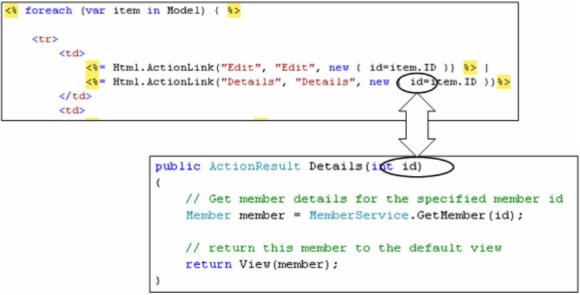
So continue to debug the code to see how the correct member is retrieved using the MemberService, and how the resulting member is passed to the default view. As a result, the Details view is rendered:
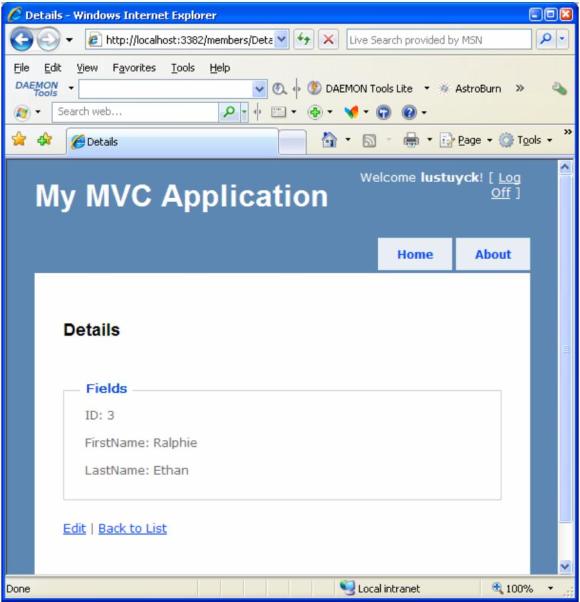
Note: The Back To List link already works, because it was implemented for us:
<%=Html.ActionLink("Back to List", "Index") %>
Task 2: making the Create New link work
First, update our Model code so that we can create a new member. Open the MemberService class in the Model folder, and add the following method:
public static void CreateMember(Member member)
{
// Set member id to next free id
member.ID = members.Max(m => m.ID) + 1;
// add member to collection
members.Add(member);
}
This method takes care of adding a new member to the collection and making sure it gets a valid id.
Then, in the Index.aspx view in the Views/Members folder, the Create New link looks like:
<%= Html.ActionLink("Create New", "Create") %>
The second parameter is the name of the action method, so this means that we have to create a new action method Create in the MembersController class (if we don’t specify the controller name explicitly, it will take the current one, which is fine in this case):
public ActionResult Create()
{
return View();
}
If the Create New link is clicked, the Create action method of the MembersController will be executed, and in this method we just return the default view for creating new members. This view does not exist yet, so right click the Create action method and select Add View, and make sure everything is filled in as follows:
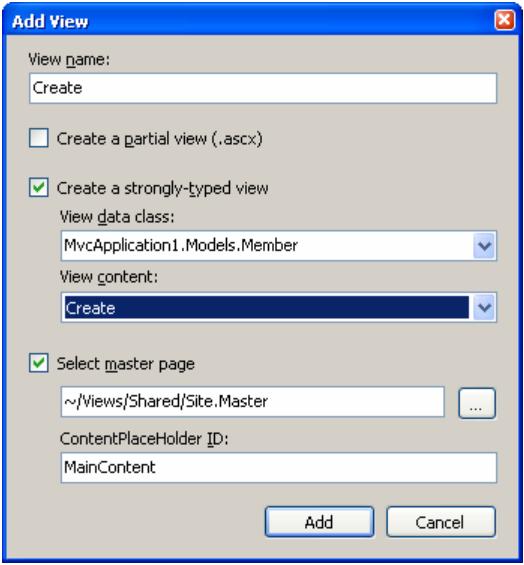
Make sure that:
- The View name is called Create.
- You check the Create a strongly typed view check box, and set the View data class to MvcApplication1.Models.Member. This way, we will be able to access the member data in the view in a strongly typed way.
- Select Create as the View content. This will generate code that displays the creation of a member.
Click Add and a new view called Create.aspx will be added to the Views/Members folder:
<%@ Page Title="" Language="C#"
MasterPageFile="~/Views/Shared/Site.Master"
Inherits="System.Web.Mvc.ViewPage<
MvcApplication1.Models.Member>" %>
<asp:Content ID="Content1" ContentPlaceHolderID="TitleContent"
runat="server">
Create
</asp:Content>
<asp:Content ID="Content2" ContentPlaceHolderID="MainContent"
runat="server">
<h2>Create</h2>
<%= Html.ValidationSummary("Create was unsuccessful. Please correct
the errors and try again.") %>
<% using (Html.BeginForm()) { %>
<fieldset>
<legend>Fields</legend>
<p>
<label for="ID">ID:</label>
<%= Html.TextBox("ID") %>
<%= Html.ValidationMessage("ID", "*") %>
</p>
<p>
<label for="FirstName">FirstName:</label>
<%= Html.TextBox("FirstName") %>
<%= Html.ValidationMessage("FirstName", "*") %>
</p>
<p>
<label for="LastName">LastName:</label>
<%= Html.TextBox("LastName") %>
<%= Html.ValidationMessage("LastName", "*") %>
</p>
<p>
<input type="submit" value="Create" />
</p>
</fieldset>
<% }
%>
<div>
<%=Html.ActionLink("Back to List", "Index") %>
</div>
</asp:Content>
To try this view, run the application, go to http://localhost:3382/members/index and click the Create New link. Or, immediately type in the url http://localhost:3382/members/Create:

Note: The id property of a member is auto-generated by the data access layer, so you can safely delete this in the view because a user should not be able to fill this in.
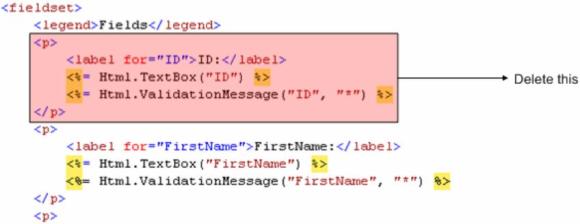
This view uses the Html.TextBox helper to generate textboxes to fill in the required data.
Also notice the Html.BeginForm statement:
<% using (Html.BeginForm()) { %>
which will generate a form-element:
<form action=”/members/Create” method=”post”></form>
So, when the Create button is clicked (which is of input type submit), a new POST request to http://localhost/members/create is triggered and all form data will be passed with it. This means that the action method Create of the MembersController will be executed. But hold on… again? When we clicked the Create New link previously, this same action method was executed? What is happening?
To understand how it works, you have to know the difference between GET and POST requests. When we clicked the Create New link, a new GET request was triggered, causing the Create action method to execute. We could have explicitly written the Create action method as:
[AcceptVerbs(HttpVerbs.Get)]
public ActionResult Create()
{
return View();
}
If you don’t specify the AcceptVerbs attribute, it defaults to HttpVerbs.Get. That’s why the Create New link executes the Create action method when clicked.
But now, when clicking the Create button, we have the intention of creating a new member – which is potentially an unsafe operation, and therefore should be handled by a POST request instead of a GET request. Indeed, the generated Create button triggers a POST request, and in order to handle it, we have to create a new Create action method in the MembersController but this time decorated with HttpVerbs.Get, and accepting a member parameter.
[AcceptVerbs(HttpVerbs.Post)]
public ActionResult Create(Member member)
{
// Use model to create this new member
MemberService.CreateMember(member);
// Redirect to Details action method and pass the new id
return RedirectToAction("Details", new { id = member.ID });
}
Again, thanks to model binding the member parameter is created and its properties (FirstName and LastName) are initialized with the data from the form – so we don’t have to do anything special to get the data out of the request. Then, the model is used to actually create the new member and then a RedirectToAction result is returned to trigger a redirection passing the name of the action method to redirect to (Details) and the data to be passed to this action method (the id).
Previously we already wrote this Details action method, so it will already work: when the new member is created, its details will be shown.
Test it: run the application, and create a new member:
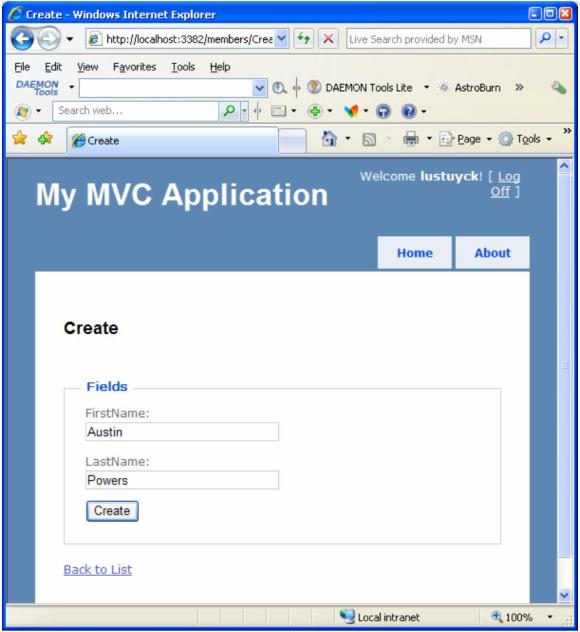
When you click Create, the member will be created and you will be redirected to the details view:
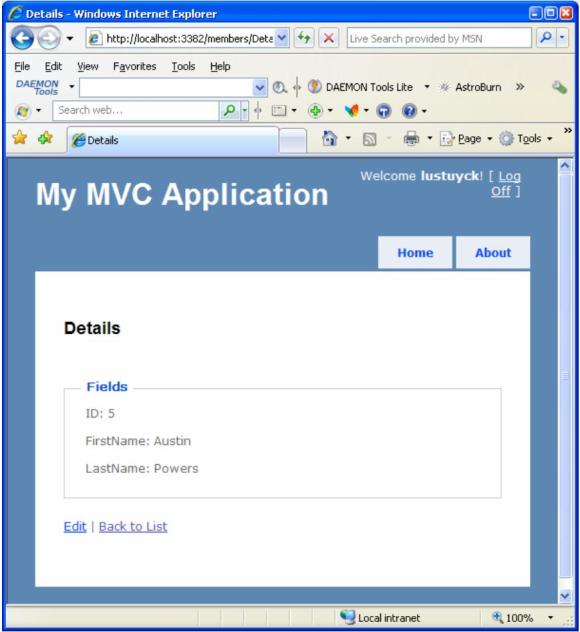
As you see, the id was generated fine. Now click the Back to List link, and the new member will be visible in the list:
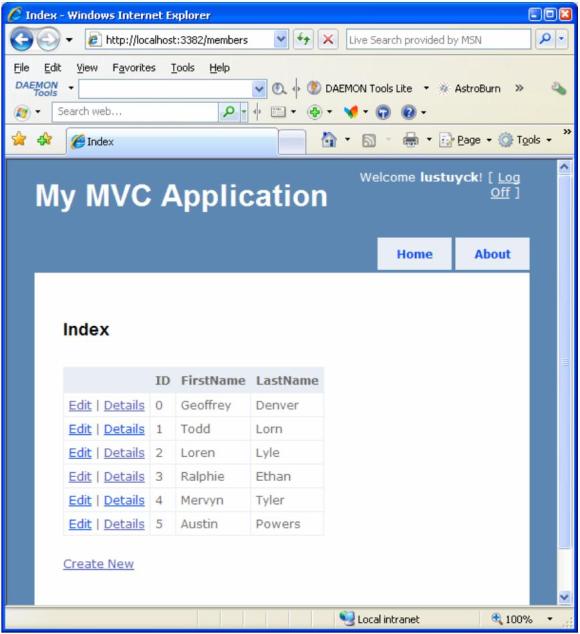
Task 3: making the Edit link work
Update our Model code so that we can update an existing member. Open the MemberService class in the Model folder, and add the following method:
public static void UpdateMember(Member member)
{
// Find member in collection
Member foundMember = members.Find(m => m.ID == member.ID);
// Update member
foundMember.FirstName = member.FirstName;
foundMember.LastName = member.LastName;
}
The Edit link in the Index.aspx view looked like:
<%= Html.ActionLink("Edit", "Edit", new { id=item.ID }) %>
This means that we have to add a new action method called Edit to the MembersController that will handle the GET request (and show the form to edit a member):
[AcceptVerbs(HttpVerbs.Get)]
public ActionResult Edit(int id)
{
// Get member details using model
Member member = MemberService.GetMember(id);
// Return default view and pass member
return View(member);
}
If the Edit link is clicked, the Edit action method of the MembersController will be executed, and in this method we first get the member details for the passed member id, and then return the default view for editing a member. This view does not exist yet, so right click the Edit action method and select Add View, and make sure everything is filled in as follows:

Make sure that:
- The View name is called Edit.
- You check the Create a strongly typed view check box, and set the View data class to MvcApplication1.Models.Member. This way, we will be able to access the member data in the view in a strongly typed way.
- Select Edit as the View content. This will generate code that displays the editing of a member.
Click Add, and the Edit.aspx view will be created in the folder Views/Members. In this view, remove the id like you did in the Create view, because we don’t want users modifying it. Run the application and click the Edit link next to a member:
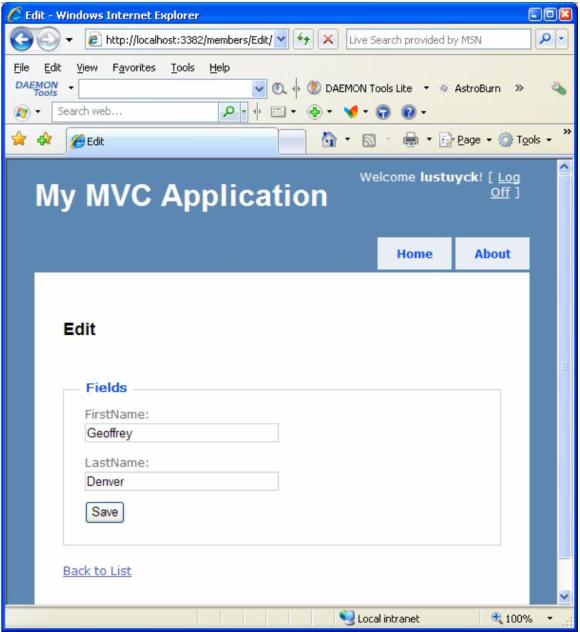
So change first name and/or last name and click Save. Guess what? An error is shown, because – you guessed it – we didn’t write code to handle the POST request yet.
Add new action method called Edit again but this time to handle POST request (and actually saves the updated member using the model). Open the MembersController class and add the following action method:
[AcceptVerbs(HttpVerbs.Post)]
public ActionResult Edit(Member member)
{
// Use model to update this existing member
MemberService.UpdateMember(member);
// Redirect to Details action method and pass the id
return RedirectToAction("Details", new { id = member.ID });
}
Run the application again, and rename Loren Lyle to Laura Lyle:
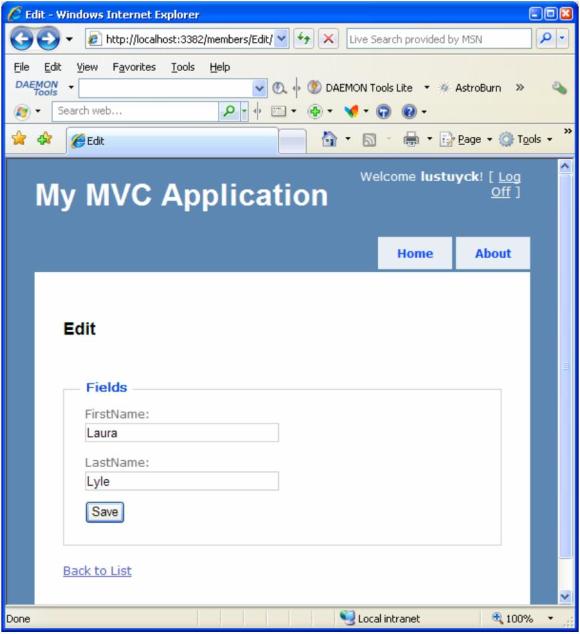
Click Save:
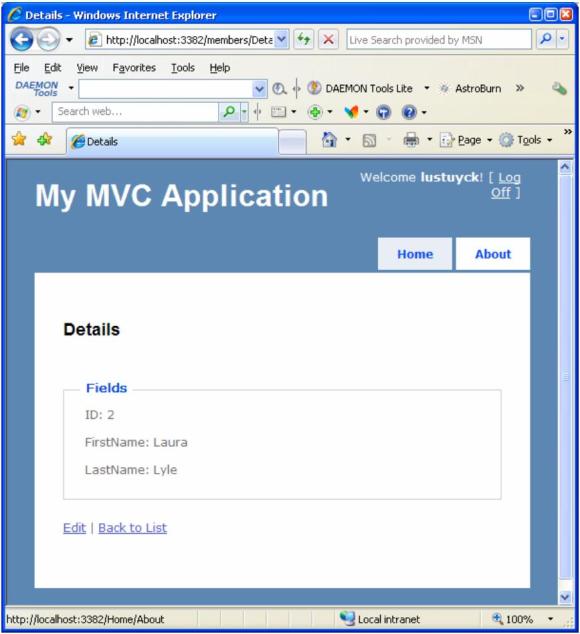
And if you go back to the list, it will also display the new name:
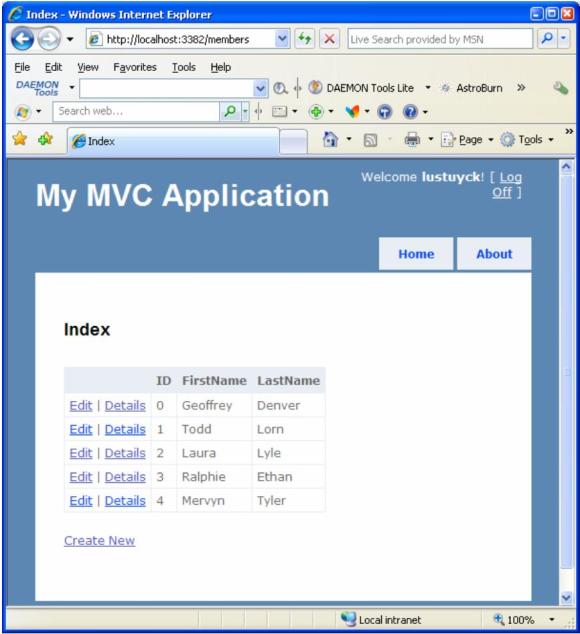
Task 4: making the Delete link work
As always, first update our Model code so that we can delete an existing member. Open the MemberService class in the Model folder, and add the following method:
public static void DeleteMember(int id)
{
// Find member in collection
Member memberToDelete = GetMember(id);
// Delete member
members.Remove(memberToDelete);
}
There wasn’t a Delete link in the Index.aspx view yet, so we will add it now:

This means that we have to add a new action method called Delete to the MembersController that will handle the GET request (and show the form to delete the member):
[AcceptVerbs(HttpVerbs.Get)]
public ActionResult Delete(int id)
{
// Get member details using model
Member member = MemberService.GetMember(id);
// Return default view and pass member
return View(member);
}
If the Delete link is clicked, the Delete action method of the MembersController will be executed, and in this method we first get the member details for the passed member id, and then return the default view for deleting a member. This view does not exist yet, so right click the Delete action method and select Add View, and make sure everything is filled in as follows:
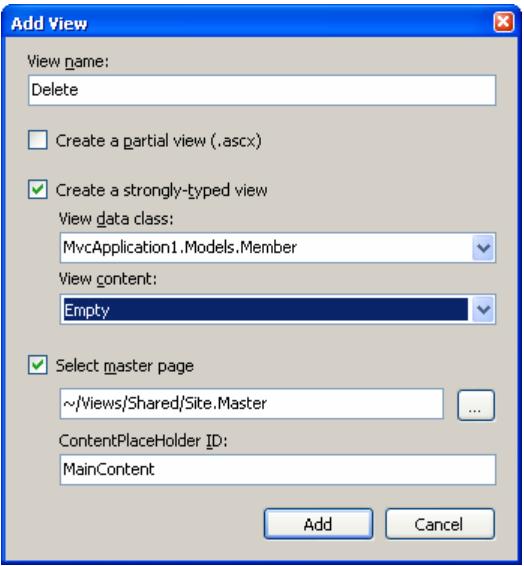
Make sure that:
- The View name is called Delete.
- You check the Create a strongly typed view check box, and set the View data class to MvcApplication1.Models.Member. This way, we will be able to access the member data in the view in a strongly typed way.
- Select Empty as the View content. We will add some HTML manually.
Click Add, and the Delete.aspx view will be created in the folder Views/Members. Make this view look like:
<%@ Page Title="" Language="C#"
MasterPageFile="~/Views/Shared/Site.Master"
Inherits="System.Web.Mvc.ViewPage<
MvcApplication1.Models.Member>" %>
<asp:Content ID="Content1" ContentPlaceHolderID="TitleContent"
runat="server">
Delete
</asp:Content>
<asp:Content ID="Content2" ContentPlaceHolderID="MainContent"
runat="server">
<h2>Delete</h2>
Do you really want to delete <%= Model.FirstName %>
<%= Model.LastName %>?
<%using (Html.BeginForm(new { id = Model.ID })) { %>
<p>
<input type="submit" value="Delete" />
</p>
<% } %>
<div>
<%=Html.ActionLink("Back to List", "Index") %>
</div>
</asp:Content>
To handle the actual Delete, add new action method called Delete again but this time to handle POST request (and actually deletes the requested member using the model). Open the MembersController class and add the following action method:
[AcceptVerbs(HttpVerbs.Post)]
public ActionResult Delete(Member member)
{
// Use model to delete this existing member
MemberService.DeleteMember(member.ID);
// Redirect to Index action method
return RedirectToAction("Index");
}
That should do it! Run the application, and delete the member Todd Lorn:
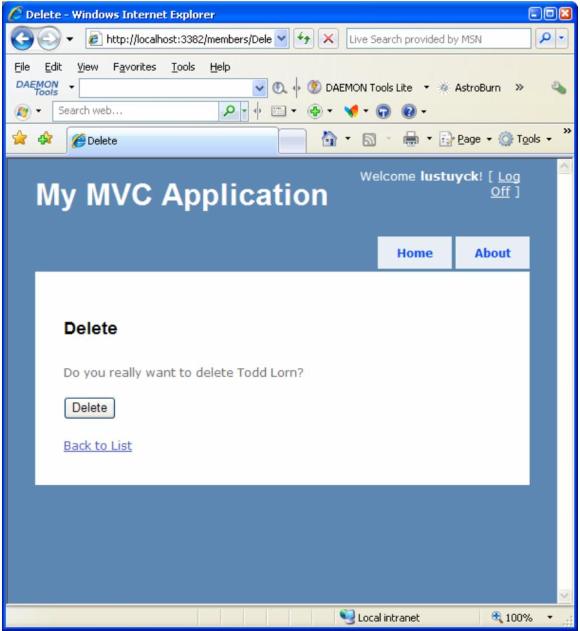
Click Delete, and the member will be deleted:
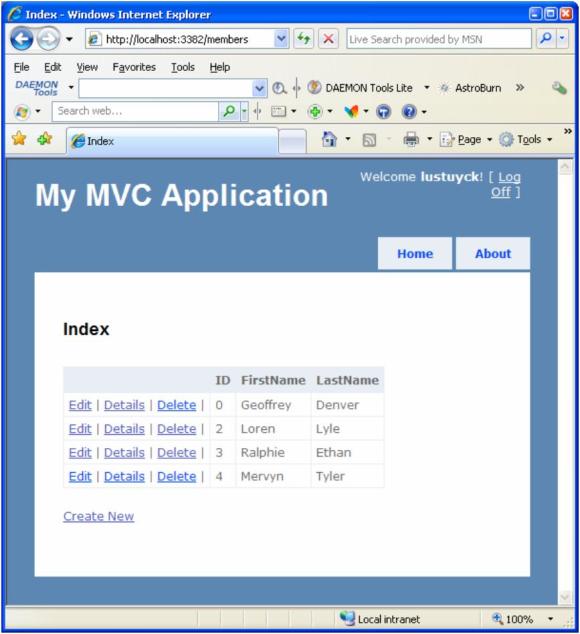
Go to next part.
